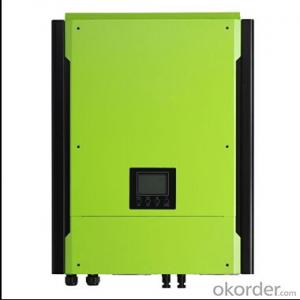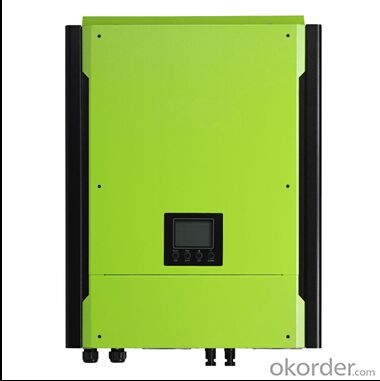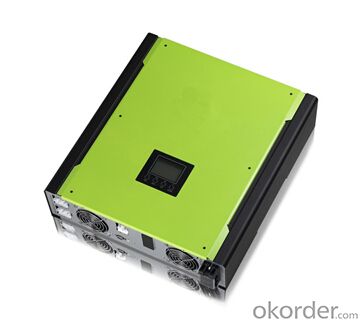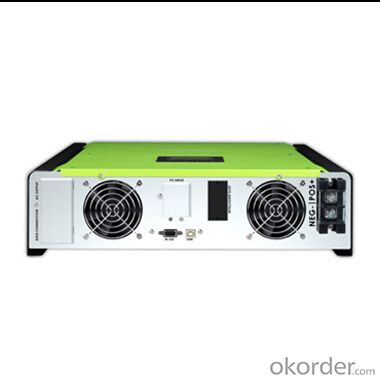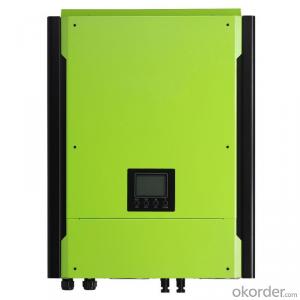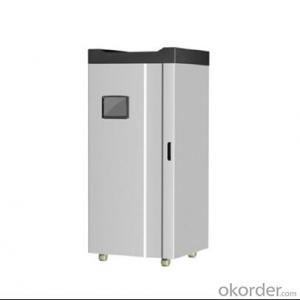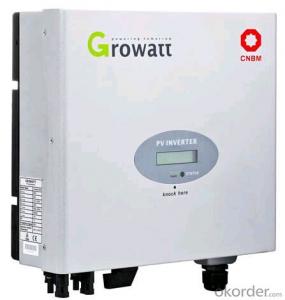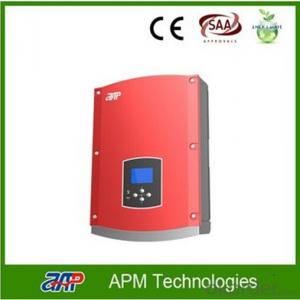400W Solar Inverter On-Grid Energy Storage PV Inverter PH500 Series 1-Phase 2KW
- Loading Port:
- China main port
- Payment Terms:
- TT or LC
- Min Order Qty:
- 60000 watt
- Supply Capability:
- 16000000 watt/month
OKorder Service Pledge
OKorder Financial Service
You Might Also Like
1. Structure of On-Grid Energy Storage PV Inverter Description
On-Grid Energy Storage PV Inverter is a hybrid inverter which combines solar system, AC utility, and battery power source to supply continuous power• It is suitable for the remote areas where the cost of utility is too high or emergency usage when utility is not stable.
2. Main Features of the On-Grid Energy Storage PV Inverter
• 2KW on-grid inverter with energy storage
• Pure sine wave output
• Microprocessor controlled to guarantee stable charging system
• Multiple operations: Grid tie, Off grid, and grid-tie with backup
• Built-in MPPT solar charger
• LCD display panel for comprehensive information
• Multiple communication
• Green substitution for generators
• User-adjustable battery charging current
3. On-Grid Energy Storage PV Inverter Images
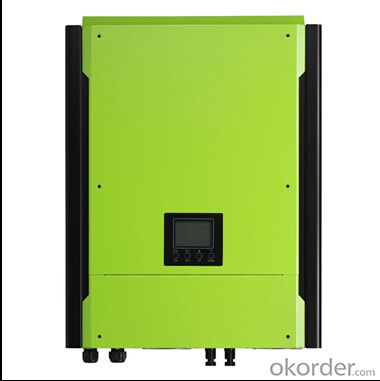
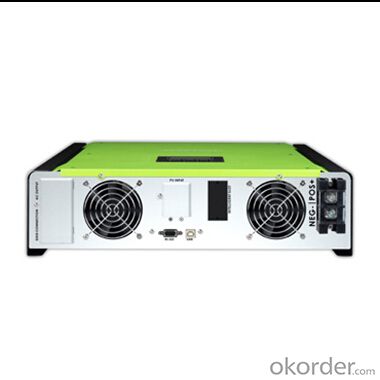
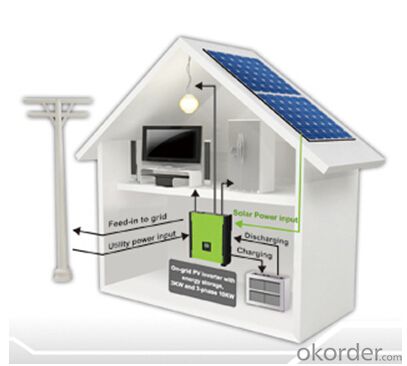
4. On-Grid Energy Storage PV Inverter Specification
Model | PH500 Single-phase 2KW |
RATED POWER | 2000 W |
GRID-TIE OPERATION | |
PV INPUT (DC) | |
Maximum DC Power | 2250W |
Nominal DC Voltage / Maximum DC Voltage | 300 VDC / 350 VDC |
Start-up Voltage / Initial Feeding Voltage | 80 VDC / 120 VDC |
MPP Voltage Range | 150 VDC ~ 320 VDC |
Number of MPP Trackers / Maximum Input Current | 1 / 1 x 15 A |
GRID OUTPUT (AC) | |
Nominal Output Voltage | 101/110/120/127 VAC |
Output Voltage Range | 88 - 127 VAC* |
Nominal Output Current | 18 A |
Power Factor | > 0.99 |
EFFICIENCY | |
Maximum Conversion Efficiency (DC/AC) | 0.95 |
European Efficiency@ Vnominal | 0.94 |
OFF-GRID OPERATION |
|
AC INPUT | |
AC Start-up Voltage/Auto Restart Voltage | 60 - 70 VAC / 85 VAC |
Acceptable Input Voltage Range | 85 - 130 VAC* |
Number of MPP Trackers / Maximum Input Current | 30 A |
PV INPUT (DC) | |
Maximum DC Voltage | 350 VDC |
MPP Voltage Range | 150 VDC ~ 320 VDC |
Maximum Input Current | 1 / 1 x 15 A |
BATTERY MODE OUTPUT (AC) | |
Nominal Output Voltage | 101/110/120/127 VAC |
Output Waveform | Pure Sinewave |
Efficiency (DC to AC) | 0.9 |
HYBRID OPERATION | |
PV INPUT (DC) | |
Nominal DC Voltage / Maximum DC Voltage | 300 VDC / 350 VDC |
Start-up Voltage / Initial Feeding Voltage | 80 VDC / 120 VDC |
MPP Voltage Range | 150 VDC ~ 320 VDC |
Maximum Input Current | 1 / 1 x 15 A |
GRID OUTPUT (AC) | |
Nominal Output Voltage | 101/110/120/127 VAC |
Output Voltage Range | 88-127 VAC |
Nominal Output Current | 18 A |
AC INPUT | |
AC Start-up Voltage/Auto Restart Voltage | 60 - 70 VAC / 85 VAC |
Acceptable Input Voltage Range | 80 - 130 VAC* |
Maximum AC Input Current | 30 A |
BATTERY MODE OUTPUT (AC) | |
Nominal Output Voltage | 101/110/120/127 VAC |
Efficiency (DC to AC) | 0.9 |
BATTERY & CHARGER | |
Nominal DC Voltage | 48 VDC |
Maximum Charging Current | 25A |
GENERAL | |
PHYSICAL | |
Dimension, D x W x H (mm) | 420 x 415 x 170 |
Net Weight (kgs) | 15.5 |
INTERFACE | |
Communication Port | RS-232/USB |
Intelligent Slot | Optional SNMP, Modbus, and AS-400 cards available |
ENVIRONMENT | |
Humidity | 0 ~ 90% RH (No condensing) |
Operating Temperature | 0 to 40°C |
Altitude | 0 ~ 1000 m** |
5. FAQ of On-Grid Energy Storage PV Inverter
Q1. What is the difference between inverter and On-Grid Energy Storage PV Inverter?
A1. Inverter only has AC inpput, but On-Grid Energy Storage PV Inverter both connect to AC input and solar panel, it saves more power.
Q2. What is the difference between MPPT&PWM?
A2. MPPT has higher efficiency, it can track the max power point and won't waste energy.
Q3. What is the waranty of product?
A3. 12 months.
- Q: How does a solar inverter handle voltage and frequency variations caused by grid faults?
- A solar inverter is designed to handle voltage and frequency variations caused by grid faults through a process known as grid support or anti-islanding function. When a grid fault occurs, such as a sudden drop in voltage or frequency, the solar inverter detects the disturbance and responds accordingly. To handle voltage variations, the solar inverter typically incorporates a voltage control mechanism. It monitors the grid voltage continuously and adjusts its own output voltage to match the grid voltage level. In the event of a voltage drop or spike caused by a grid fault, the inverter adjusts its output voltage accordingly to maintain a stable and safe operating condition. This helps protect both the solar system and the grid from potential damage. Similarly, the solar inverter also deals with frequency variations caused by grid faults. It constantly monitors the grid frequency and adjusts its own output frequency to match the grid frequency. If a grid fault results in a sudden change in frequency, the inverter responds by adjusting its own frequency accordingly. This ensures that the solar system remains synchronized with the grid and continues to supply power without disruptions. Additionally, solar inverters are equipped with anti-islanding protection, which means they are designed to quickly disconnect from the grid in the event of a grid fault. This is a safety measure to prevent the solar system from continuing to supply power to a faulty grid, which could pose a risk to utility workers trying to repair the fault. Overall, a solar inverter's ability to handle voltage and frequency variations caused by grid faults is crucial for the safe and efficient operation of a solar power system. By continuously monitoring the grid conditions and adjusting its output accordingly, the inverter ensures that the solar system remains in sync with the grid and provides stable and reliable power.
- Q: How does a solar inverter handle voltage sags or swells in the grid?
- A solar inverter handles voltage sags or swells in the grid by continuously monitoring the grid voltage. When a sag or swell is detected, the inverter adjusts its output voltage accordingly to maintain a stable and consistent supply of power. It does this by regulating the amount of power it injects into the grid or by temporarily disconnecting from the grid to protect itself and other connected devices. This helps to prevent damage to the inverter and ensures that the solar system can continue operating efficiently even during voltage fluctuations.
- Q: Photovoltaic grid-connected inverter without DC emc how will happen
- Solar photovoltaic power generation technology is the use of solar cells, the photovoltaic effect of semiconductor materials, solar radiation can be directly converted into a new type of power generation system, solar energy is a radiant energy, solar power means --- to direct conversion of sunlight Into electricity,
- Q: Are solar inverters compatible with battery storage systems?
- Solar inverters and battery storage systems are indeed compatible. They play a vital role in combining solar power and battery storage. Solar inverters convert the DC electricity generated by solar panels into AC electricity, which can be used to power our homes and businesses. On the other hand, battery storage systems store excess solar energy for later use, enabling us to utilize solar power even when the sun is not shining. When paired with solar inverters, battery storage systems can be charged during the day using excess energy from the solar panels and then discharge that stored energy at night or during periods of high energy demand. To ensure compatibility, solar inverters used in battery storage systems come equipped with additional features and functionalities. For instance, they may have built-in charge controllers that regulate the charging and discharging of the batteries, ensuring optimal performance and longevity. Advanced inverters may also incorporate smart grid capabilities, allowing them to communicate with the utility grid and optimize energy flows based on grid conditions and electricity prices. All in all, solar inverters are vital components in seamlessly integrating battery storage systems with solar power. They enable us to maximize the advantages of clean and sustainable energy.
- Q: How does a solar inverter handle power export limitations imposed by the grid?
- A solar inverter handles power export limitations imposed by the grid through a process known as grid-tied or utility interactive operation. It continuously monitors the grid's voltage and frequency, adjusting the power output of the solar system accordingly. If the grid is unable to accept additional power due to export limitations, the inverter will reduce the output of the solar system to ensure compliance with the grid's requirements. This allows for a smooth and safe integration of solar power into the grid, preventing any potential disruptions or overloading.
- Q: What is the role of a galvanic isolation circuit in a solar inverter?
- The role of a galvanic isolation circuit in a solar inverter is to provide electrical separation and insulation between the DC input side (solar panels) and the AC output side (grid connection). This isolation helps to protect the solar inverter and the electrical grid from potential hazards such as voltage surges, ground faults, or electrical noise. It also improves the safety of the system by reducing the risk of electric shock and prevents the flow of potentially damaging currents.
- Q: Can a solar inverter be connected to a generator?
- Yes, a solar inverter can be connected to a generator. This allows the solar energy system to work in conjunction with the generator, providing additional power when the solar energy is insufficient or unavailable. The generator serves as a backup power source, ensuring a continuous supply of electricity.
- Q: Can a solar inverter be used in remote areas without access to the grid?
- Yes, a solar inverter can be used in remote areas without access to the grid. Solar inverters are designed to convert the DC power generated by solar panels into AC power that can be used to run electrical appliances. In remote areas, where there is no grid connection, solar inverters can be used in off-grid or standalone systems to provide electricity for various purposes, such as lighting, charging batteries, or powering small appliances. These systems typically include solar panels, batteries for energy storage, and the solar inverter to convert the stored energy into usable AC power.
- Q: What is the maximum output voltage of a solar inverter?
- The maximum output voltage of a solar inverter depends on its design and specifications. Generally, the maximum output voltage can range from 240 to 600 volts for residential inverters, and up to several thousand volts for commercial or utility-scale inverters.
- Q: How does a solar inverter handle voltage fluctuations?
- A solar inverter handles voltage fluctuations by constantly monitoring the input voltage from the solar panels and adjusting its output voltage accordingly. It maintains a stable output voltage even when there are fluctuations in the input voltage, ensuring that the electricity generated by the solar panels is suitable for use in the electrical grid or for powering appliances.
Send your message to us
400W Solar Inverter On-Grid Energy Storage PV Inverter PH500 Series 1-Phase 2KW
- Loading Port:
- China main port
- Payment Terms:
- TT or LC
- Min Order Qty:
- 60000 watt
- Supply Capability:
- 16000000 watt/month
OKorder Service Pledge
OKorder Financial Service
Similar products
Hot products
Hot Searches
Related keywords
